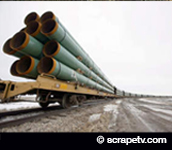Time is Right to Consider Smart Tools for Pipelines
Dr. John Bartlit
New Mexico Citizens
for Clean Air & Water
Column of January 22, 2017, Los Alamos Monitor
 Politics leads the nation in constant fights for and against new pipelines. So why do so few partisans on either side sing out for smart tools on pipelines?
Politics leads the nation in constant fights for and against new pipelines. So why do so few partisans on either side sing out for smart tools on pipelines? No matter how you view pipelines, President Trump has timely chances to change the old ways.
“Smart tools” is a broad term for the steady stream of 21st century devices with computer chips that continuously inspect, analyze and report on the state of health of almost everything. Smart tools are known to business and industry for saving costs and improving the reliability of products and operations. Smart tools are used in fields as diverse as health care, farming, manufacturing, home security systems and maintenance of infrastructure.
To maintain public safety, smart tools yield rapid, routine knowledge of the health of large civil structures, such as tall buildings, bridges, aircraft and pipelines. Over the years, this field evolved into a speciality with its own name – Structural Health Monitoring (SHM).
SHM has a rich history. The discipline of SHM has an international society of its own with its own technical journal. The 10th International Workshop on SHM was held in 2015 at Stanford University. Princeton offers a graduate course in SHM. Researchers at the national laboratory in town work on SHM.
A good overview of the history and scope of SHM is on the Internet at “structural health monitoring - Wikipedia.” Much early work in the field focused on bridges and skyscrapers. As knowledge broadened, SHM proceeded to find applications with railroad tracks, common aircraft and pipelines. Improvement is continual.
For years, the airline industry has funded research to develop SHM techniques that meet US requirements for periodic aircraft inspections. Airlines now have techniques that are shown to meet inspection requirements and do it more reliably, continuously, at less cost. Airlines are now busy persuading regulators to use the modern tools.
I claim no great expertise, yet I know that an e-search of “SHM for pipelines” returns years of information on the subject. To sum it up, much is known and tested, including good reasons to use SHM on major pipelines. Piping materials can age, wear and corrode. This is why the industry uses “pigs” that can be run through a pipeline to detect weak spots. For 50 years, pipeline pigs have gotten more and more capable.
SHM goes a large leap further by automating real-time inspections, analysis and reporting. New options also offer easier and more timely pipe repairs.
President Trump is a businessman. He likes to make deals. Among his most urgent, frequent points in campaign talks was the need to end bad deals in public matters. Good deals proceed from ample information. How could the new president turn pipelines into better deals for the country?
If President Trump were to write an approval for a new pipeline, the same approval could easily include written requirements that promote better, faster and cheaper monitoring and repairs for pipelines. Better deals start with ideas. Time for a kick-start:
-
Pipelines are important. If there were credible evidence that damaging leaks in pipelines are a thing of the past, the industry would display and explain the data in big ads to drive home modern safety. Why not show us? Plainly, better inspecting and repair are needed.
President Trump could approve a pipeline conditioned on a fair investment in advanced SHM to inspect, analyze and report pipeline health more efficiently. A fair amount to specify from companies for purchases and/or research funds would be, say, 20 percent of the dollars put into lobbying for pipelines, including campaign donations. This sum is a measure of the high value of pipelines.
Companies may already rightly fund the research, as airlines did. If so, they would be pleased to say so by agreeing to the requirement.
At any time, shining the political spotlight on advanced Structural Health Monitoring is a sea change from neglecting newer safeguards.